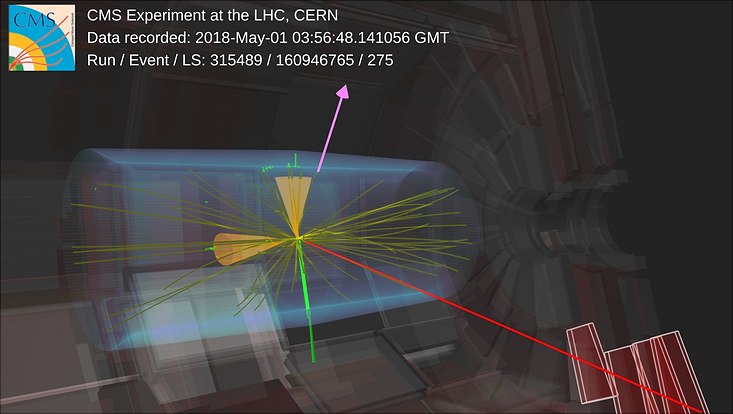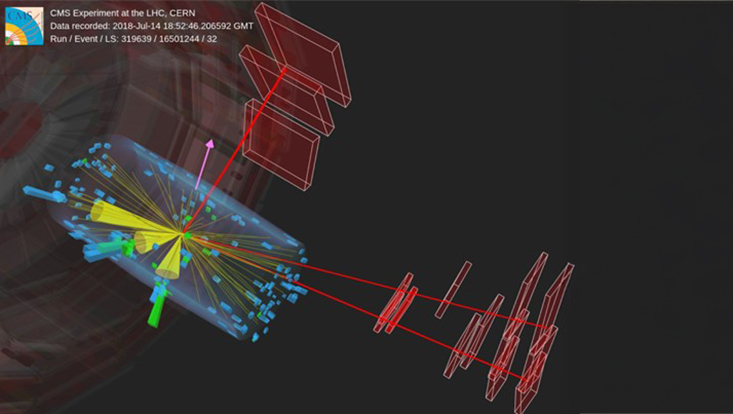CMS collaboration observes a new effectDetailed study of collisions with top quarks points to unknown structure
23 October 2024

Photo: CMS Collaboration
A group of scientists from the University of Hamburg’s cluster of excellence Quantum Universe and DESY in collaboration with the University of Rochester (USA) observed an unexpected excess in the production of pairs of top quarks and their antiquarks with the CMS detector at CERN’s particle accelerator Large Hadron Collider. This interesting finding in the data is very likely to point to an unknown structure.
In their analysis, the team of Christian Schwanenberger, professor at the University of Hamburg and DESY scientist, and Alexander Grohsjean, researcher at the University of Hamburg, compared the proton-proton collisions at the CMS detector with the state-of-the-art theoretical predictions. “The unexpected excess in the production of pairs of top quarks and their antiquarks occurred near the mass threshold, where the available energy is just enough to create top quark and top antiquark,” explains Grohsjean. The effect was first seen in the data from 2016 and has now further increased after analysis of the data recorded in 2017 and 2018. “Does the top quark form a bound state with its own antiparticle before decaying? We are not sure yet what we are seeing, but we are pretty sure it’s not just a statistical fluctuation,” Schwanenberger says.
Science at the Large Hadron Collider has an inbuilt proofing mechanism: Discoveries can only be claimed when both multi-purpose detectors, CMS and ATLAS observe the same things. However, the team of Quantum Universe and DESY scientist Katharina Behr from the ATLAS collaboration does not observe a significant effect in their data. Their analysis is optimised for a slightly different range of top-quark energies, and so far, cannot confirm the excess their CMS colleagues see. “The discussions among the two teams comparing our results, our hypotheses, and the theoretical models we use will be extremely exciting and have just started,” says Laurids Jeppe, Quantum Universe PhD researcher at DESY. This project is an example for fruitful collaboration within “Quantum Universe”, since it brings together the cluster’s experimental physicists from ATLAS and CMS with the cluster’s theorists to solve the puzzle.
The top quark is the heaviest elementary particle in the Standard Model of particle physics and is the only quark to be observed on its own. All other quarks can only ever be seen in bound states, such as forming new particles with other quarks. The top quark also shares a strong connection with the Higgs boson, which is responsible for giving mass to all elementary particles. Thus, the top quark plays a key role in exploring the Higgs boson itself and the possible existence of heavier versions of the Higgs boson.
The key to this analysis is a property of particles known as 'spin,' which can be thought of as an intrinsic form of angular momentum. Spin can have values of 0, ½, or 1. The Higgs boson, discovered in 2012, has a spin of 0, classifying it as a scalar particle. Heavier Higgs-like particles, predicted by some theories, could also decay into pairs of top quarks and may either be scalar (like the Higgs) or pseudoscalar, a distinct type of particle with different properties.
In this analysis, measuring spin-sensitive observables revealed that the observed excess in data aligns more with the pseudoscalar hypothesis than the scalar one. This raises a crucial question: Could this be evidence of a completely new fundamental particle, or might it represent a bound state of a top quark and an antiquark, both expected to behave as pseudoscalars? Could it be just a tricky effect due to an imperfect modeling of the background which involves very challenging calculations? Or perhaps it's something even more unexpected, challenging our current understanding of particle physics? “More theoretical work is needed to model the properties of this system reliably,” says Afiq Anuar, Quantum Universe Postdoc at DESY. “Our next step will be to explore the origin of this fascinating new effect. Exciting times lie ahead!”


